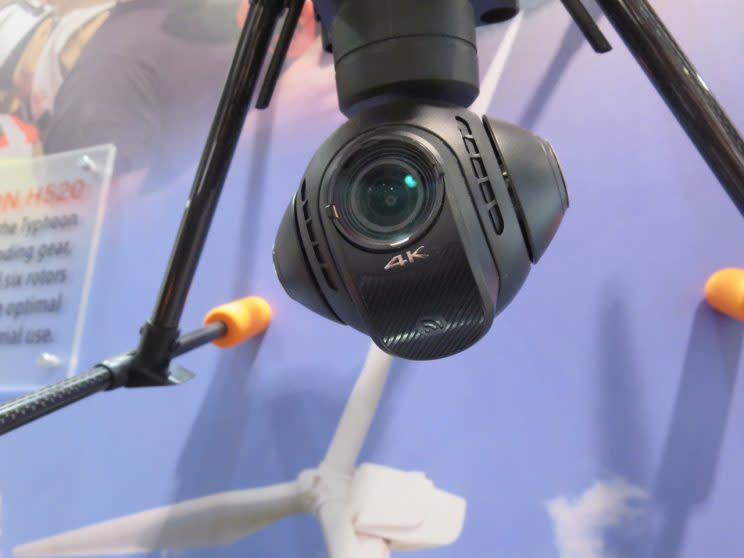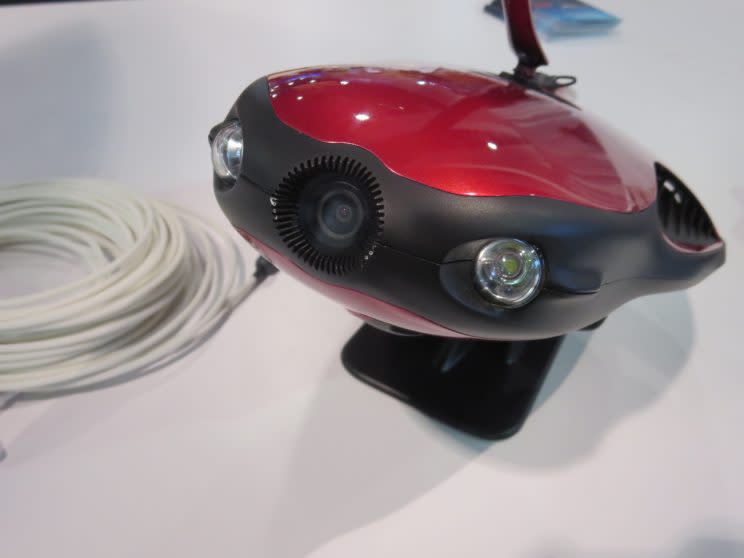Selfie drones and more fly into CES 2017

The usual soundtrack of Vegas is the incessant, looping beeps and chimes of slot machines, but at CES it’s often replaced by the high-pitched whine of drones in flight. Much of the enormous South Hall of the Las Vegas Convention Center here plays host to a flock of vendors of unmanned aerial vehicles.
Drones have become a big business, thanks to the Federal Aviation Administration’s move last year to open the skies to commercial use and the utility of drones for inspecting things like farms, solar panels, wind turbines and wireless-network towers. As CES was opening, news broke that the Chinese drone manufacturer DJI had bought a majority stake in the German camera manufacturer Hasselblad—the company that made the cameras American astronauts took to the moon.
The show floor offered further proof of the increasingly professional nature of the drone industry with UAVs like Yuneec’s H520, an industrial drone in a shade of orange often seen in road-work signs that can carry a range of sensors and will sell for $2,500. But if you have more frivolous and less practical uses in mind, CES won’t disappoint you either.
Selfie drones
The idea of the drone selfie may seem silly, but I think we can allow that the traditional family Christmas-card photo might look a little snazzier if it involved an aerial perspective. So of course vendors will ship drones optimized for this use case.
Zero Zero Robotics’ Hover Camera Passport, $599, packs a 13 megapixel camera, a battery good for about 10 minutes of flight time, and a software bundle that includes auto-follow capability into a compact assembly that folds up for easy carrying. Its rectangular enclosure safeguards its four rotors, while its .534-lb. weight keeps the drone below the FAA’s .55-lb threshold that requires owners to register their drones.

(That registration program turned a year old Dec. 21; by that anniversary, the FAA announced that it had received more than 616,000 registrations.)
The $399 Rova, another selfie drone, doesn’t fold up and, at .595 lbs., is subject to the FAA’s registration requirement. It includes a 12-megapixel camera and also offers about 10 minutes of flight time.
Sink and swim
The “A” in UAV can stand for “aquatic” just as easily as “aerial,” something I realized after discovering the PowerVision PowerRay. This underwater drone is aimed at gadgetry-minded fishing enthusiasts. You toss the drone overboard from your boat, with a cable tether providing communication, and use its 12-megapixel camera to look for fish.
An integrated light both lures and illuminates fish. PowerVision also plans to sell an optional sonar fish-finder that will attach to the PowerRay’s underside. Because swimming takes less effort than flying, the drone should be able to dive for up to four hours. But the PowerRay won’t be cheap. A representative estimated that the drone would start at $1,500 when it ships in the fall.
The inevitable Star Wars tie-in
There is no greater marketing force in the galaxy than “Star Wars.” So the arrival of a set of drones modeled after some of the hardware in George Lucas’s ongoing space opera was inevitable. Propel Toys’ “Star Wars” drones sell for $199.99 and take the form of a TIE fighter, an X-Wing or an Imperial speeder bike.

The drones each feature both battle lasers and sensors to detect when they’ve been illuminated by another drone, so you can stage aerial battles. When a drone is “hit” it descends to the ground.
A drone that flies you
At the far more expensive end of the spectrum is the Ehang 184, a drone designed to take a single occupant on short trips. I first saw this at last year’s CES, when the marketing pitch suggested that the drone could streamline the commutes of particularly rich individuals. A year later, prototypes have undergone more than 200 remotely operated flight tests in China, and the company is no longer pitching this as a particularly ostentatious form of personal transportation. The publicist I spoke to instead suggested higher-minded uses like medical transport.
But even if the $300,000 Ehang 184 ships as promised, I’m sure some dot-commer will buy one just to get around town. And, of course, they’ll take a drone selfie in mid-flight.
More of Yahoo Finance’s CES coverage:
T-Mobile’s One ‘All In’ plan is killing hidden fees and giving cash back
Samsung unveils gaming laptops and a partnership with Google
Carnival is turning its ships into floating connected hotels
Email Rob at rob@robpegoraro.com; follow him on Twitter at @robpegoraro.


